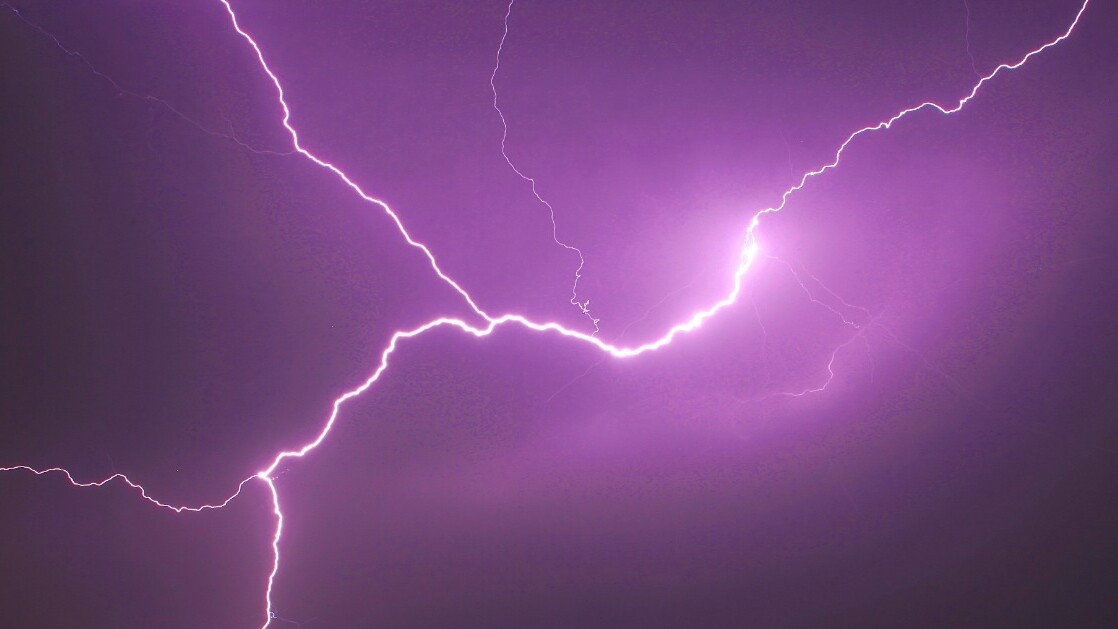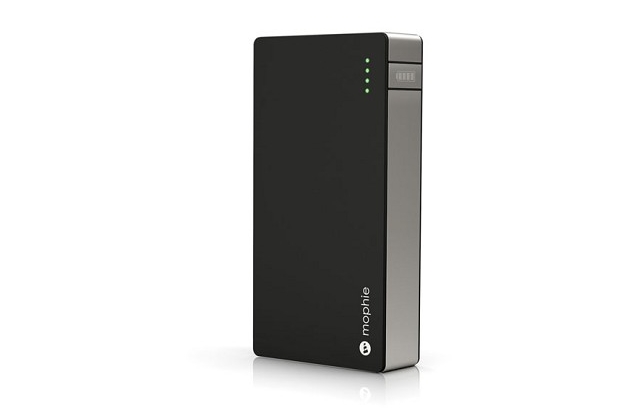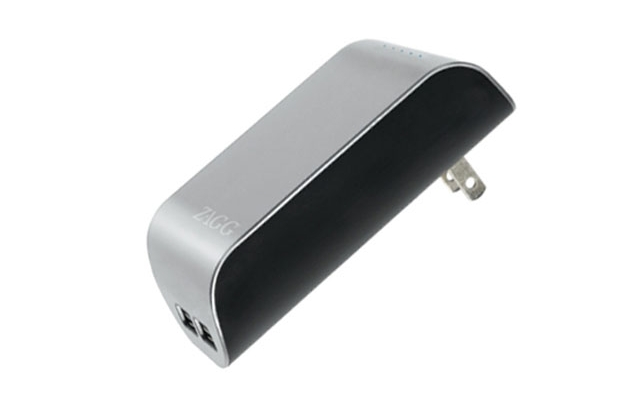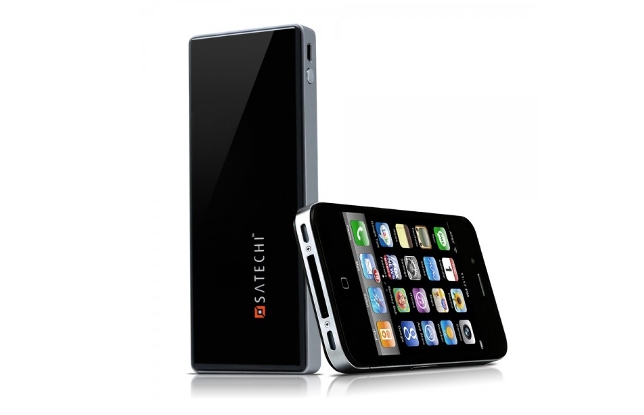
This post originally appeared on The Wirecutter – A list of amazing gadgets.

If you’re looking for a high-capacity USB battery pack that’ll charge your USB-powered gadgets while travelling, I’d recommend the Satechi Portable Energy Station 10000 for $60.
When you’re looking for USB battery pack, you should make sure that it provides enough additional power to the hardware you want to use it with that it’ll be worth your while to carry it (duh.) It should be compact and shaped in such a way that it’s not a pain to pull out of a satchel, backpack or purse. It should be light enough that when you carry it, you forget that it’s there until you need it. When the time comes to use it, it should be adaptable: you’ll want it to be capable of charging from a number of different power sources, and you’ll want it to be able to charge the majority (if not all) of the USB-powered mobile hardware you own, including 2.1 amp devices, like the iPad. Finally, it should have charge indicator lights built into to it, so you can tell how much juice is left when you’re using it, and how far along it is when you’re recharging it.
I found that of all of the USB battery packs that I researched and tested, the Satechi Portable Energy Station 10000 most adequately addressed all of these needs with the least amount of compromise.
(This pack we choose is about the size of three fingers wide, and as long as the base of your palm to first knuckles. It’s not for daily carry. We started to dive into packs that are smaller for daily use, with just enough charge for a few minutes or hours of added gadget time, and will write that article later. This article is for packs useful during trips of several days or a day of heavy gadget usage.)
USB Battery Pack reviews: where are the sources?
Unfortunately, as with many of the things I end up testing for The Wirecutter, the existing reviews and comparisons weren’t comprehensive or informative enough to cite as our only sources. That’s not to say that there aren’t a lot of battery reviews out there–there’s tons. But very few offer direct head-to-head comparisons and the ones that do are lackluster at best.
Gizmodo put together a roundup late last year, but it only included three batteries and they were from a wide range of mAh classes, so they weren’t really directly comparable. It’s like reviewing a Prius and SUV head to head; they’re both good in their own way, but for different people and situations. The same goes for CNET: Their most recent external battery pack round up was out of date, featuring batteries that in some cases were over three years old, and in other cases were no longer available, right beside stuff that dropped in late 2012. Also, many of the batteries featured failed to list much in the way of data for why anyone would want to buy them over a similarly specced battery also profiled on the site—strange, considering how solid most CNET tend to be, right?
The hardware hacking types that spend their time on XDA’s user forums provided a good deal of personal insight into which batteries packs work well for them (which is important considering the fact that jailbreaking or rooting some tablets and smartphones can result in diminished battery performance,) but personal insight can’t match facts when you’re trying to figure out the complicated backend of something as banal as picking a good external battery pack. Because of this, I’ve spent the past few months on and off researching external battery packs available online and in stores. I trawled the halls of CES for them and skulked through box stores like Best Buy, FutureShop and Walmart scoping them out.
What portable USB Battery did I test?
I started off with a list of 32 different battery packs, chosen for their size, high user ratings, favourable editorial reviews and on the recommendations of store staff, including ZAGG’s SPARQ 6000mAh battery, New Trent’s iGeek, iCarrier and iTorch batteries, the PowerGen 8400mAh External Battery Pack, Goal Zero’s Guide 10 Plus Battery Pack, Hyper’s HyperJuice Micro, a variety of well-user-reviewed offerings from Anker, and Monoprice’s 9283 5000mAh External Battery Pack. I eliminated any batteries that weighed more than a pound (because who wants to haul around something that heavy all day,) as well as any that are limited to one type of device (bye bye 30-pin iPod dock connectors).
Then, I passed on anything provided less than 1200 mAh of power. Most modern smartphones have higher capacities than that and a good backup battery should at the very least be able to provide at least one full charge. Not to mention, many of the batteries in that capacity range lack the current necessary for charging higher-power devices like tablets. I carry one with me in my bag wherever I go. When I need to use it, I do so and then jam it back in my pack. Having a higher maximum capacity also means you’re not totally out of luck if you forget to recharge it between uses.
Using this rationale, I was able to cull the number of batteries I’d be looking at from 32 down to 19. They came from a wide range of companies, including Hyper, Eton, New Trent, ZAGG, Goal Zero, Monoprice, Innergie, Mophie and Satechi. I called them all in for testing.
After going hands on, I eliminated another 14 batteries from the running based on their crappy build quality, inability to charge from more than one power source (batteries that can only be charged via wall socket aren’t as versatile), those that offered a poor power to dollar ratio, or that were just poorly designed. This meant nixing anything that was a pain to pull out of my bag, got in the way of other things I was pulling out of my bag, or was generally too bulky for an accessory that should be utterly forgettable until you need to use it.
A shortlist of the best five
In the end, I was left with five batteries that I felt might be worth your time and money: Eton’s BoostBloc 4000, the Satechi Portable Energy Station 10000, Mophie’s PowerStation Duo, Hyper’s HyperJuice Mini, the Innergie PocketCell Duo.
In addition to all of the points that took the other batteries out of the running, for the final five remaining battery packs, I turned my attention to how many ports each came equipped with, and how much power was routed to each port. Two USB ports is better than one, for obvious reasons, and higher marks were given to battery packs with at least one port capable of providing 5V/2.1 amps of power or higher. The ability to provide this kind of power is important as high draw devices like the New iPad or a Nexus 10 tablet typically refuse to be charged by anything less. And while most people will likely use a portable battery pack to top off their smartphone on the go, I wanted to be sure that I recommended something to you that’d provide some versatility of purpose, should you need it.
Finally, I looked at the ratio of mAh to weight for each of the final five batteries because anything you carry in your travels, no matter whether they’re to a different country or to a class across campus, needs to be able to pull it’s own weight. Otherwise it doesn’t deserve a place in your rucksack.
Our Pick: a review of the best portable USB battery pack
Of the five batteries that were left in the running, the Satechi Portable Energy Station 10000 proved to be the best buy because it offered the most features for the least amount of compromise. Its compact size makes it easy to carry, it’s reasonably priced, and lasts through about 3 days of regular use between charges.
First, let’s talk design. The Satechi measures in at a long and lean 5.5″ x 2″ x 0.75”. Given that most of the things that we carry daily like tablets, laptops, notebooks and the like are long, lean and relatively flat as well, the dimensions of the Energy Station 10000 make a lot of sense. I found that it was easy to slide into a relatively slim bag like Filson’s Original Briefcase even when it was also hauling around my laptop, iPad, a textbook for a night class I’ve been taking and the small emergency supply kit I carry with me everywhere I go. Perhaps more importantly, the battery was easy to pull out of the bag when the time came to use it. I didn’t have to remove the contents of my bag to get at it, or even shift stuff around to get my hands on it. It was just there: slim and easy to get to.
This svelte form factor is in direct opposition to most other companies, which design their external battery packs to be thick and stout. The result is a brick that doesn’t take up much space, but often finds itself lost and sunk at the bottom of your bag, which can make it a hassle to get to if you’re packing a lot of stuff.
The price isn’t large either: $60 for 10,000 mAh worth of power. It’s not the cheapest $ to power ratio, but to get cheaper, you have to sacrifice portability (think pound-plus bricks) and/or the ability to charge the pack via USB. Not worth it.
Furthermore, the Satechi isn’t too heavy and that’s great. It weighs 7.4 ounces, which isn’t super light, but it’s still a lot lighter than to the one pound Mophie PowerStation Duo (a battery which I’ve relied on almost daily for close to a year,) it’s certainly isn’t heavy either.
It also has two USB ports which let you charge multiple devices simultaneously. One provides 5V/1 amp of power, which will charge most smartphones, the other is a 5V/2.1 amp port, so you’ll be able to use it to charge devices that draw more power like the New iPad, or even some newer cameras, like the Sony NEX-F3. The 2.1 amp port also charges small devices quicker, like using an iPad charger on an iPhone.
In order to ensure that the battery performs as well as Satechi claims, I tested it out (along with the other 19 batteries I ended up calling in.) After wearing my iPhone 5’s 1440 mAh battery down to the bone, I found that I was able to charge it about six and a half times, which translates to about 9360mAh total. Although that’s under the claimed 10000, it’s actually pretty good considering the inherent inefficiencies involved in transferring energy between batteries. As for my iPad mini, I forced it to run Jim Jarmunch movies until it died. After plugging the tablet into the the Energy Station 10000, I got roughly another 8 hours out of it. The tests were conducted running the phone and tablet with auto brightness and bluetooth turned off. Additionally, both devices were Wi-Fi connected. Of course, your experience will likely vary: No one uses their hardware in exactly the same way. You might play more games on your tablet than I do. You might text more, and I prefer keeping my phone on vibrate because the world is loud enough already.
The 7200mAh HyperJuice Mini came in second behind the Satechi battery, giving me six full recharges of my iPhone 5 and Just over six hours worth of iPad mini video playback. Third place was Innergie’s 6800 mAh Pocket Cell Duo, which managed to charge my iPhone 5.5 times and provide me with about 5.5 hours of video on my iPad mini. While both performed well, they’re too expensive for what you get compared to the Satechi.
Of the 19 battery packs that I spent time with, the Energy Station 10000 offered the best volume to mAh ratio. This means that the battery’s size and the space it will take up in your bag is the most justifiable of any of the batteries I tested. It’s hard to escape a metric like that. The second place honors for power-to-volume ratio goes to the Innergie PocketCell Duo, but again, I don’t think that the PocketCell Duo is worth your money. It costs more than the Energy Station 10000 does and serves up a lot less power. If you’re interested in the details, I’ll get into them in a bit.
The Energy Station 10000 makes it easy to know how much power’s in it. When you get it out to use it, it’s easy to see how much power you’ve got to play with thanks to the five blue LEDs mounted in its glossy black top. Push a button on the side of the battery, and they’ll show you the rough percentages of what juice you’ve got left to use. And when you’re charging it up, the lights will also show your progress. The button also acts like a power button, which helps to avoid unwanted discharge. Speaking of charging, we may as well talk about that.
You can charge the Energy Station 10000 from a couple of different power sources. Like I mentioned earlier, I’m not down with battery packs that require a special adapter or wall socket to charge up. When I first first read about ZAGG’s ZAGG SPARQ series of batteries, New Trent’s iCarrier and Hyper’s crazy huge $130 HyperPlug battery, I was excited, in a nerdy kind of way, to have the option to recharge the things right from a wall socket, as it seems like such a logical way to do things: No cables to lose or carry. But sometimes outlets can be hard to come by, such as when you’re in a car with a USB charger but no 3-hole outlets. The Satechi charges via Mini USB, but it also comes with a power adapter you can plug into its included USB cable. Should you forget it, there’s always the option of plugging it into your phone charger or computer USB port as well.
It comes ready to use with most gadgets. The Energy Station 10000 also comes with six interchangeable adapter heads that you can use with the included cable. When the battery’s done charging, remove the cable from the Energy Station 10000’s mini USB port, switch over to the appropriate adapter head, insert the other end of the cord into one of the battery’s two USB ports and start charging gadgets.
Who else likes it?
While there weren’t a lot of external battery roundups for me to rely on, individual reviews of external battery packs are pretty easy to come by. And there’s a lot of love for the Energy Station 10000.
TUAW’s Kelly Hodgkins touted the Energy Station 10000’s long lasting power, saying “On more than one occasion, I charged my iPad to an acceptable level and then handed the Satechi to my husband who used it to charge his iPhone while he was away for the morning. When he returned, I could then finish off the iPad charge cycle and still have 20 percent left on the power pack.”
GottaBeMobile’s Kevin Purcell was also impressed by what the Energy Station 10000 had to offer, noting that he “…I tested the Satechi 10000 mAh Portable Energy Station by charging up my Samsung Galaxy Note to 100 percent and charging the Satechi to 100 percent. I plugged my Note into the Satechi and then used it heavily. With the Note’s battery and the Satechi’s battery my phone lasted for over 30 hours. My Note normally lasts 6-8 hours by itself, so the Satechi gave me another 22 hours of battery life. That’s saying something since few charging solutions can charge the Note when used the way I normally use it.”
Gadling’s Kraig Becker called the battery a great travel option and said it was “small, lightweight and highly packable.” There were also favourable reviews for the Energy Station 10000 from Gadget Review, Tech Reaction, AppAdvice.com, and travel site Vagabond Dish.
The Wirecutter’s own Brian Lam owns one too. In one of the emails he shot me after finding out that the Energy Station 10000 proved to be the best pick out of everything I tested, he told me “I love the Satechi, by the way. It packs really well. The square ones piss me off. The other great thing about the it is that you can stand it up in a bag pocket and the plugs hang out the top.” So there’s that.
But it’s Not Perfect
There were a few things about it that I didn’t like.
For starters, the battery’s relatively light weight comes at a cost: Its shell is made entirely out of plastic. While that’s not a deal-breaker, the fact that the plastic is of a particularly light and cheap feeling variety makes me wonder how well it’ll stand up to wear and tear. I can tell you that its shiny black and silver surface are a fingerprint and scuff magnet. But this doesn’t negate any of the thing’s functionality, so not a big deal.
Slightly more annoying is the fact that it uses mini USB instead of the now-ubiquitous micro USB. It’s better not to have to carry multiple different types of cables and if your cables work interchangeably between devices, all the better in case you lose one.
I also don’t like the fact that the charging adapters that it comes with are so small and easy to lose. Satechi includes a drawstring pouch that’ll hold the battery and all of its various cables and bits, but meh, it feels cheap. It likely won’t matter though. If you’re anything like me, you’ve got more than one cable to charge your favourite devices with, so the cable and adapter heads that the Energy Station 10000 ships will will likely wind up in a drawer a few days after you buy one.
Furthermore, in dim light, and in direct sunlight, I found it hard to read the text under the USB ports that tells you which was the low-powered port and which was the high-powered one. But I think we can file that under nit-picking.
It should be noted that while I didn’t have any issues with the Energy Station 10000 during testing, iLounge’s Nick Guy did. He had a hard time getting the battery to take a charge with its included accessory cable, had issues with its charge indicator lights and felt, given the Satechi’s charging time, that it wasn’t actually providing a full 2 amps of power from its USB ports. I reckon Nick must have wound up with a defective unit, given that the rest of the editorial reviews for the Energy Station 10000 are overwhelmingly positive. I did manage to find an Amazon customer who felt that he was only getting maybe 5000mAh out of the battery, but he was willing to admit that he may very well have received a unit with a dud cell or two.
The Competition

If the Satechi Energy Station 10000 doesn’t do it for you, you could go with Mophie’s Power Station Duo. I’ve owned one for close to a year, use it often and it’s served me well. But the Power Station Duo is a 6000mAh battery and it sells for $100. That’s 4000mAh less for $40 more, and the Mophie weighs a whole pound, so not only is it more expensive for less power than the Satechi, it’s heavier too. Knowing what I do about the Satechi battery now, I can’t say that I’d buy the Mophie again.
You might also consider Hyper’s 7200mAh Hyperjuice Mini. Like the Energy Station 10000, it has two USB ports, a charge indicator and is long and slender as opposed to thick and bulky. It’s worth noting that the Hyperjuice’s all metal casing is a lot more resilient than the cheap plastic the Satechi’s wrapped in. But like the Mophie, the Hyperjuice costs $100 and provides less power than the Satechi. Not worth it.
If you want to see what else you can get for $60, take a look at Eton’s BoostBloc 4000: As much as I dig Eton’s emergency radios, I can’t for the life of me justify buying a 4000 mAh made of similar materials to one that is rated for 10000mAh. For the same price. And while I really liked the design of Innergie’s 6800mAh PocketCell Duo, once again we’re talking about a less capable battery that sells for $40 more.
Furthermore, none of these other models came a USB power charger whereas the Satechi does. Not a dealbreaker, but it’s nice to have.

ZAGG’s Sparq series of external batteries come in 1220mAh, 3100mAh and 6000mAh capacities, but the 6000mAh SPARQ costs $110 and can only be plugged into a wall to recharge.
Eton’s BoostTurbine 2000 is a 2000mAH battery that can be charge via mico USB or with a built-in turbine, but it holds less power than the Energy Station 10000 does, and is bigger and heavier to boot, so put it in your emergency kit, but leave it out of your day-to-day life.
I normally love Monoprice’s gear, but the build quality of their $30 5000mAh external battery pack was disappointingly poor, and while it was light, it took up just about as much space in my bag as the Satechi battery did.
The New Trent iCarrier battery is ragingly popular on Amazon, and provides 12000mAh of power for just under $80. But it weighs over a pound, it creaks when you squeeze it and the wall charger it comes with is almost as big as the battery itself. The same can be said of the company’s smaller iGeek battery.
Anker’s Astro3 10000mAh Multi-voltage External Battery Pack enjoys some good ratings on Amazon as well, and it sells for $40, but it’s heavier than the Energy Station 10000 and doesn’t appear to be in production anymore (Anker’s got a new version of the battery listed, but it’s not yet readily available for purchase.)
And while the $42 EasyAcc 4 x USB Output Port 12000mAh External Battery Pack looks like an amazing option, I think it weighs too damn much to bother carrying, and if you read the small print on its Amazon listing, you’ll find that while it has four USB ports, it can only charge “…2 Tablets or 3 Smart Phones simultaneously at most.” So that’s no good.
Honestly, out of all of the batteries I looked at, the 19 I tested, and the five that passed the standards I set and tests I conducted, I can tell you that right now, the best high capacity battery pack is the Satechi Energy Station 10000.
Alternatives to a huge battery?
That’s cool. Not everyone needs a battery that can help them get through a day of heavy use on a smartphone, tablet or whatever. If your power needs lean more towards needing to top off your phone at the end of the day than staying juiced up on a cross country flight, I’ll have a recommendation for a smaller battery pack—or even a few—soon.
Wrapping it up
To reiterate, the Satechi Portable Energy Station 10000‘s compact size makes it easy to carry, it’s reasonably priced, and can last through three full days of regular use between charges. All these make it a great pick for anyone who regularly finds themselves in need of extra juice for their electronics.
This article contains affiliate links that may earn revenue for us or our syndication partners when clicked. However, our first priority is always you, the reader and we only link to products relevant to this article.
Image Credit: ChinaFotoPress/Getty Images
Get the TNW newsletter
Get the most important tech news in your inbox each week.





